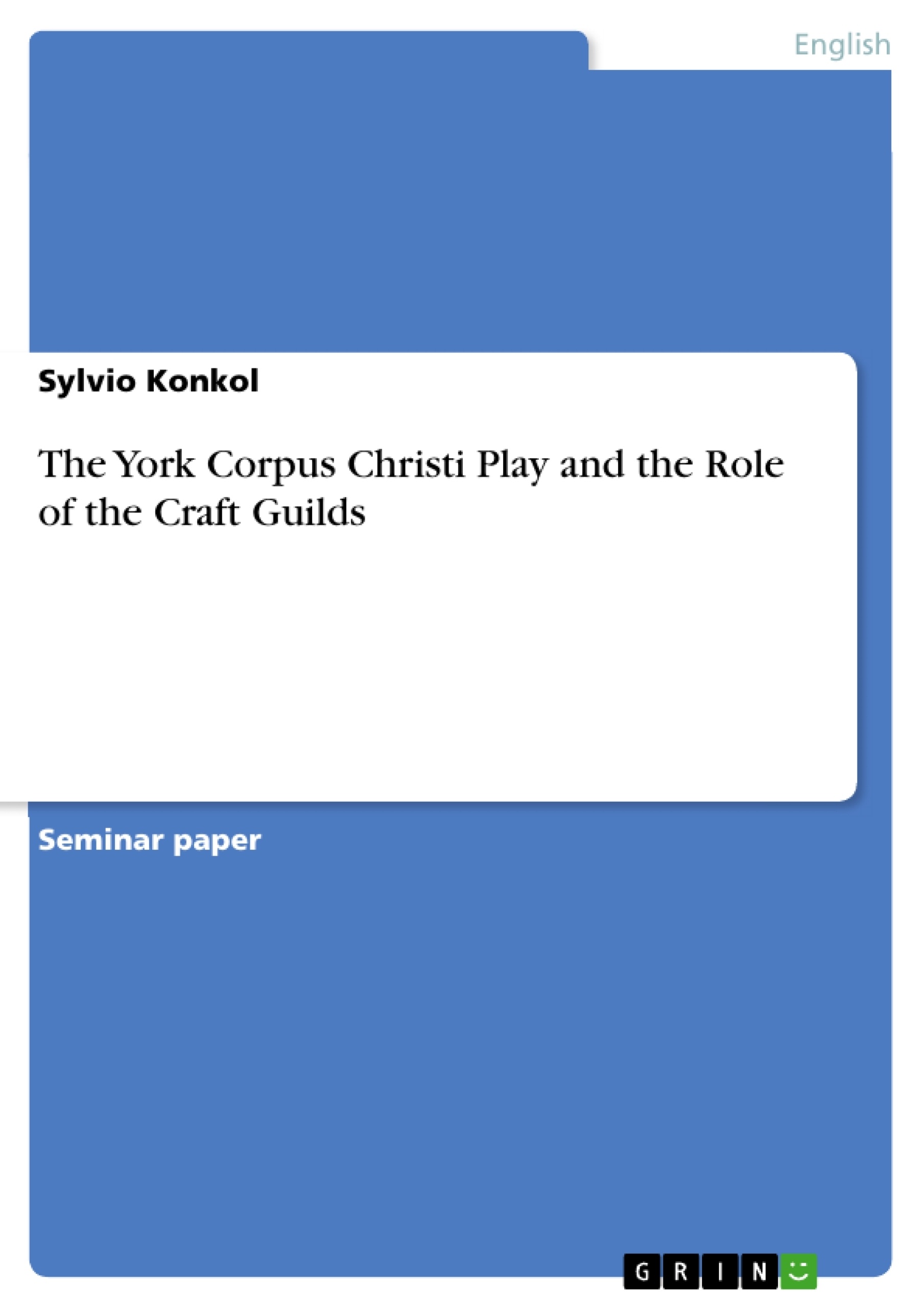In the late Middle Ages, so called 'mystery plays' enjoyed great popularity in English towns and especially in those of the north. Many of these plays were grouped in greater cycles among which the cycle of York, commonly known as the "York Mystery Plays", is the best preserved, and presumably one of the oldest, largest and most elaborate ones as well. Its forty-seven constituent plays are concerned with Christian belief and sacred history, a circumstance reflected in the collection's authentic title – the Corpus Christi play.
It is interesting that the term 'mystery plays', an invention of the 18th century, does not only point to the content of the cycle, as the alternative expression 'miracle plays' does. The term simultaneously addresses those associations of people that were responsible for the cycle's staging: the trade and craft guilds of a town. Based on the archaic meaning of the word, denoting a 'handicraft or trade', it was occasionally referred to these guilds as 'mysteries' as well. In the case of the dramatic cycle of York, each individual play was assigned to one (or in some cases two) of these 'mysteries' or guilds.
This paper aims at investigating the role these guilds played in the organisation, the funding and the staging of the cycle. It can be argued that aside from their more obvious economic and social functions, the medieval trade and craft guilds also had a cultural function in the narrow meaning of the term. Further can be argued that the Corpus Christi cycle was not only a cultural and a ritual event, but that it had an important social (and perhaps even an economic) function for the city of York and the communal life of its inhabitants. In fact, it may be this interplay of various domains of life and thought that can explain how the cycle could survive in the form of an annual performance for a period as long as two hundred years, and why it came into being as well as disappeared not randomly but at certain moments in history.
Looking upon the play as a civic rather than an ecclesiastical affair, this work thus investigates the cycle's link with the economic history of York and the organisational development of the trade and craft guilds. It will be shown in particular that as a sort of 'producers' the guilds had a range of clearly defined responsibilities and that among these the aspect of funding was the most central.
Inhaltsverzeichnis (Table of Contents)
- Introduction
- The York Corpus Christi Play
- The Text and Other Sources
- Content and Mode of Performance
- The Role of the Trade and Craft Guilds
- Trade and Craft Guilds in the Middle Ages
- Craft Guilds and the York Corpus Christi Cycle
- Responsibilities
- Financing
- Conclusions and Summary
Zielsetzung und Themenschwerpunkte (Objectives and Key Themes)
This paper investigates the role of trade and craft guilds in the organization, funding, and staging of the York Corpus Christi play. The paper argues that beyond their economic and social functions, medieval guilds had a significant cultural role in the community. It further explores how the Corpus Christi cycle served as a cultural, ritual, and social event, highlighting its impact on the city of York and its inhabitants. The paper aims to understand how the cycle could sustain itself for two centuries through its annual performance, its origins, and its eventual decline.
- The significance of trade and craft guilds in medieval England
- The role of guilds in organizing, funding, and staging the York Corpus Christi play
- The cultural and social impact of the Corpus Christi cycle on the city of York
- The interplay of economic, social, and cultural factors influencing the cycle's longevity and decline
- The historical development of the York Corpus Christi play
Zusammenfassung der Kapitel (Chapter Summaries)
- Introduction: This chapter introduces the topic of medieval mystery plays, particularly the York Corpus Christi play, and its historical context. It highlights the significance of the trade and craft guilds in staging and funding the play. The chapter also outlines the paper's objectives and research methodology.
- The York Corpus Christi Play: This chapter provides a general description of the York Corpus Christi play, exploring its textual sources, content, and mode of performance. It examines the play's historical context and discusses its significance as a collective religious expression. The chapter also explores the evolution of the play's text over time and its connection to the city's cultural and social fabric.
- The Role of the Trade and Craft Guilds: This chapter dives into the history and functions of medieval trade and craft guilds in England. It examines their economic and social roles within the community and how they transitioned into cultural institutions. The chapter then explores the guilds' specific involvement in the York Corpus Christi cycle, detailing their assigned responsibilities and financial contributions to the production.
Schlüsselwörter (Keywords)
The main keywords and focus topics of this paper are: York Corpus Christi play, medieval mystery plays, trade and craft guilds, cultural function of guilds, social impact of the play, economic history of York, liturgical feast, and the historical development of the play.
- Quote paper
- Sylvio Konkol (Author), 2013, The York Corpus Christi Play and the Role of the Craft Guilds, Munich, GRIN Verlag, https://www.grin.com/document/306053



